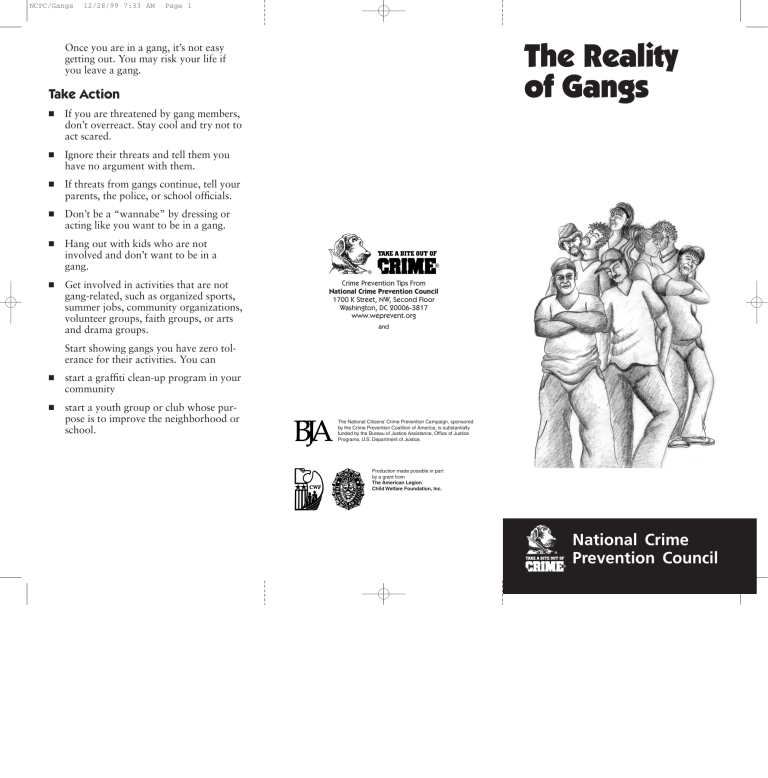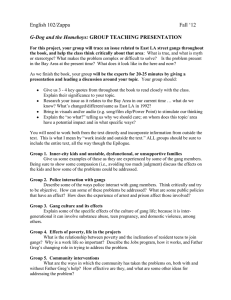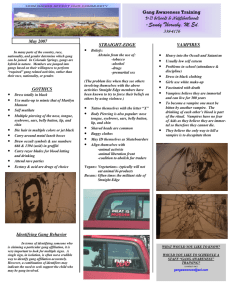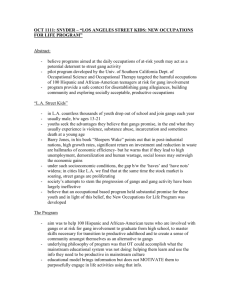The Reality of Gangs Take Action

NCPC/Gangs 12/28/99 7:33 AM Page 1
Once you are in a gang, it’s not easy getting out. You may risk your life if you leave a gang.
Take Action
■ If you are threatened by gang members, don’t overreact. Stay cool and try not to act scared.
■
■
■
■
■
■
■
Ignore their threats and tell them you have no argument with them.
If threats from gangs continue, tell your parents, the police, or school officials.
Don’t be a “wannabe” by dressing or acting like you want to be in a gang.
Hang out with kids who are not involved and don’t want to be in a gang.
Get involved in activities that are not gang-related, such as organized sports, summer jobs, community organizations, volunteer groups, faith groups, or arts and drama groups.
Start showing gangs you have zero tolerance for their activities. You can start a graffiti clean-up program in your community start a youth group or club whose purpose is to improve the neighborhood or school.
Crime Prevention Tips From
National Crime Prevention Council
1700 K Street, NW, Second Floor
Washington, DC 20006-3817 www.weprevent.org
and
The National Citizens’ Crime Prevention Campaign, sponsored by the Crime Prevention Coalition of America, is substantially funded by the Bureau of Justice Assistance, Office of Justice
Programs, U.S. Department of Justice.
Production made possible in part by a grant from
The American Legion
Child Welfare Foundation, Inc.
The Reality of Gangs
National Crime
Prevention Council
NCPC/Gangs 12/28/99 7:33 AM Page 2
What’s the Deal With Gangs?
Gangs are neither just a big city or inner city problem, nor are they a problem of a particular race or culture. Gangs cross all ethnic, racial, socioeconomic, gender, and geographic boundaries. They bring fear and violence to neighborhoods, traffic in drugs, destroy property, involve youth in crime, and drive out businesses. Gangs pull teens away from school and home into a life of violence.
One of the scariest aspects of gang violence is it’s often indiscriminate and unpredictable. Gang members have been known to kick, punch, hit, or even kill their victims. People get hurt if they are in the wrong place at the wrong time. If gangs or gang members are in your school or neighborhood, you know it.
Learn About Gangs
■
■
■
■
■
Gangs can be organized around race or ethnic group, money making activities, or territory.
Gangs usually claim a particular area of town which they call their “turf.” They spend much of their time fighting rival gangs to keep them out of this territory.
Most gang members are males ranging in age from 8 to 22 years old.
Females, especially Asian and Hispanic, are moving away from the traditional role of being merely girlfriends of gang members and are forming their own gangs.
Gangs wear particular items, styles, brands, or colors of clothing. Some gangs wear bandannas of a certain color or baseball caps of a specific team.
■
■
Some gangs mark their bodies with tattoos with their gang symbol or name.
Gangs often use special hands signs or handshakes to tell others the gang to which they belong.
“Gangsta” rap paints a realistic picture of daily gang activity. The lyrics glorify violence, abuse of women, and disrespect for authority, especially the police.
Contrary to what you may think, gangs are not around to help you. These groups of young people break the law, beat up people, and murder.
■
■
Why Do Young People
Join Gangs?
What causes some teens to join gangs?
Among the most common reasons are to
■
■
■ belong to a group receive protection earn money end boredom and seek more excitement be with friends and be more popular.
For some it is even a family tradition.
None of these reasons are good reasons to belong to a gang. Most of the other kids who don’t belong to a gang will be afraid of you and won’t hang out with you. If you think you will be safer joining a gang, you’re wrong. Most likely, you will increase your chances of being injured or killed. Think you’ll be rich?
Not likely. Over a lifetime, gang members make far less money than those who are not in gangs. And by joining you usually don’t end up with a good education, making it hard to find a good job.
Join a Gang?
■
■
■
Joining a gang is like entering enemy territory. Belonging to a gang has a warlike existence where beatings and shootings happen all the time. Typical scenarios of joining a gang involve violence and rape.
Boys usually have to fight several other gang members at the same time—this is called being “rolled-in” or “walking the line.”
Girls may be forced to have sex with several gang members or fight other female gang members.
New members may be required to prove themselves by beating up an innocent person, robbing a store, or shooting someone—including drive-by shootings.
If you break the rules after joining a gang, your punishment may be death.
What Does the Future Hold for a Gang Member?
■
■
■
■
■
■
Gang membership can severely hurt one’s health and future.
Gang members may be killed or injured.
Many put themselves in danger of disease, prison, and death.
Many become dependent on alcohol and drugs.
Gang members usually drop out of school, limiting their chances for higher education or good employment.
They are likely to be involved in crime throughout the rest of their lives.
They may commit serious and violent crimes that lead to lengthy jail time.






